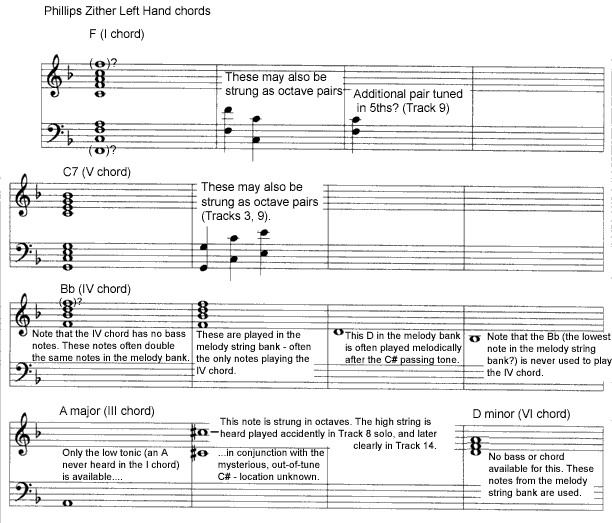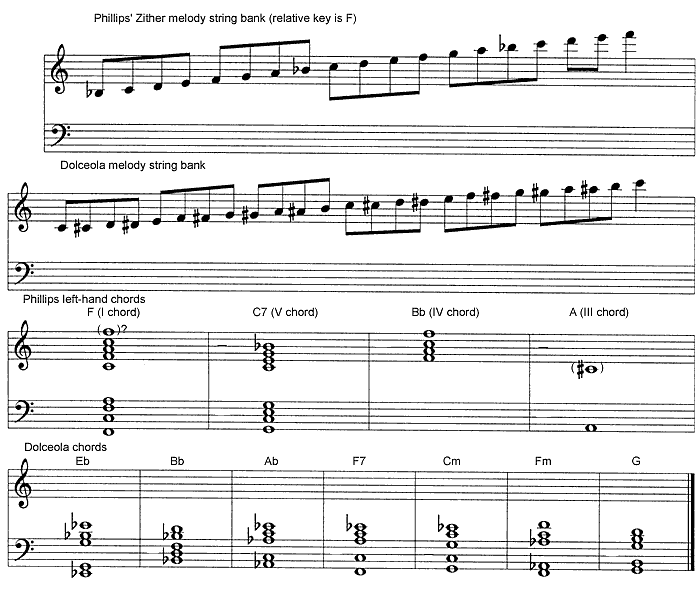For:
Note 1. Assuming
now that it wasn't a Dolceola, I have no idea where Walker could have come up
with the term. According
to Conte in the Yazoo CD liner notes, Walker was "convinced that Phillips
employed a home-made instrument," So why then, did he originally enter “novelty acc.,
dolceola."
into the files? If it was
homemade, why dolceola? Could it have reminded Walker of a Dolceola he
had seen (in person or from advertisements)? One wonders if Walker
(“sensitive to rural music” and from a farm background) was familiar with
the hundreds of models of fretless zithers in circulation, sold by the tens of
thousands between 1894 and 1927 (when he made his session notes).
Note 2. I received this very
thoughtful and generous letter from Pat (whom Andy Cohen calls "a
genius," and I found a very down-to-earth, self-deprecating fellow). He
explains,
"Yes, I was in touch with the writer (Corcoran) and followed his research along in
Texas regarding the family's thoughts on dolceolas and some kind of plucked invention
(I imagine very like a bandura) but I am not convinced there is one instrument system throughout, as
I do hear key action on several 78s and plucking arpeggios on others. The lack of any sour notes
or mis-struck adjoining strings does lend good argument that there is a string chord group being
fingerpicked. Many of us record collectors have argued over this for years with 78s in hand ready to go one way or the
other, but whatever his "invention" may be I am almost convinced that one permutation of it seems to be a dolceola re-set up for the left hand
work, with the key transport removed, and plucked. A newspaper photo showing him with two zither like things seems to confirm
one is a dolceola body. One important disadvantage to listeners of his music unfamiliar with the actual 78s themselves is that sometime reissues
cut off the final extraneous noises at the end of a performance, and I recall at least one with key action sounding.
So my feeling seems to be at least two different instruments were used over the course of his
sessions and one is really a dolceola. The other has to be plucked just for the sheer magnitude of perfectly formed chords and arpeggios that
sound seamlessly without lever action being audible."
I would have to respectfully disagree with Pat on a couple
things. First, I do hear tonal differences (miking and/or change of
instrument) and possibly stringing/tuning differences (again, 2 instruments)
in the different sessions - but, I'm sorry - I hear no key action
anywhere. Second, I considered the possibility of Phillips using a Dolceola
with the keyboard removed (indeed, one of the Phonoharp instruments may very
well be a Celestaphone with its hammer mechanism removed) - but I see no need
to go looking for another candidate instrument, when he's already shown
holding them. I'm not sure why Pat thinks one of the Phillips photo zithers is
a Dolceola body - Pat was one of the first to own and play one,
and can surely recognize one (it took collector and expert Kelly Williams to inform me which
brand and models these were, though the precise models
may not be correct [but close enough for discussion]). In
Pat's defense, the two instruments do seem to appear larger than normal in the
Phillips photo (see The Instruments of Washington
Phillips ). Third, I'm curious about the
"extraneous noises" at the end of
Phillips performances - why would there be key/hammer noise after he's
played, rather than during? Admittedly, I haven't heard them, and my
ears may not be perfect.
Note 4. I subsequently learned that Guido van Rijn first reissued the Phillips 78's as
Denomination
Blues on vinyl. He also wrote a paper on Phillips' recording sessions, which
might help shed some light on my Pitch/Session study below (however,
his
paper is based on the Dolceola theory). I have so far been unable to obtain
a copy of his invaluable research - this site is where Guido sent me: http://www.bluesworld.com/Sacre.html
Note 5. Andy's re-tuning of the
instrument is quite ingenious (just listen to his CD), and I hope to perhaps
explore it one day. I haven't analyzed it fully, but don't believe it covers
many of the notes I hear on the Phillips CD.
Note 6. I don't know either Rick
or Jim, nor
understand the "going backwards" comment. Assuming their ears are as
good or better than mine, here we have a perfect example of the nature of
sound and interpretation. As it turns out, I’m 100% sure it’s not a
Dolceola.
Against:
Note 1. I
am embarrassed beyond belief that I, myself, saw this picture on the CD cover
- but didn't pay it much attention. I would like to think that, had I
had more interest in the recording, it would've dawned on me...why is
holding a couple of typical fretless zithers if he's playing a Dolceola?
Was his Dolceola in the shop? Did someone hand these to him and say, "Here,
just hold these..."? If not a "smoking gun,"
then certainly a pretty
generous clue for all of us! Since the picture coincides date-wise with the
sessions, there is no reason not to believe that these two Phonoharps
(specially-strung, remember) were the instruments used (either of them, or
both). It would be of immense value if a better
reproduction of this image were available for analysis. I'm begging anyone who
has any knowledge of the whereabouts of the original (or good negative) to
come forward.
Note 2. I obtained this
article in February, 2003. To me, Hettrick's logic (and detail) leaves little
doubt about the unlikelihood of a Dolceola - though in print (and even in
personal correspondence) he politely remains neutral.
Note 3. Inconclusive, as
Virgil first saw Phillips several years after the sessions were completed
(see
Notes 4 & 5).
Note 4. According
to Corcoran's article, the three eyewitnesses are Cousin Virgil Keeton ("demonstrated,
with a thumb-plucking motion,
how Phillips played the strings on his instrument"), second cousin Earl
Phillips ("strings that
he strummed"), and neighbor Durden Dixon ("...Durden Dixon,
said Phillips strummed
a..."). Corcoran also informed me after the articles were
published that "there were more than three eyewitnesses from the Simsboro and Teague area who recollected Phillips
strumming. Cleo Phillips of Oklahoma was one. Doris Neely another. A couple other
eyewitnesses whose names I didn't use because it would be kind of redundant."
Pretty compelling, as
there are several of them, and these are good layperson's descriptions of
typical fretless zither technique. However, it's not impossible that what they
saw was not one of his session instruments (see Note 5 and The Instruments of Washington
Phillips).
Note 5. Corcoran
mentions three eyewitnesses: Phillips’ cousin Virgil
Keeton ("harp-like instrument that he made himself")
and Phillips’ neighbors Nell Blakely ("a
homemade banjo that he laid down flat") and Durden Dixon ("box-like
instrument he made himself out of the
insides of a piano"). The 4th is Columbia Records’ recorder Frank
Walker (this apparently from a 1961 interview with Walker. I'd like to see the
original as Pat Conte has said "Convinced that Phillips employed a
home-made instrument, Walker..." [per his liner notes for the Yazoo
release], "Walker ...recalled it as a strange 'home-made' looking
thing..." per a 1997 Internet bulletin board], and Andy Cohen quoted
Walker as "it was some contraption he built himself..." in his 1999 EMI article). The 5th is Phillips' 85-year-old second
cousin Earl Phillips, who provided many intriguing clues in a thirty minute
phone conversation I had with him on April 1, 2003 (I have Michael Corcoran to
thank for his leg-work and providing several phone numbers). However, even with five witnesses
calling the instrument "home-made" or "made by Phillips
himself," I
wouldn't necessarily expect all these laypeople to be able to look at a beat-up old Phonoharp
(almost no remnants of decals can be seen in the photo) and necessarily
realize it was originally a production instrument. Additionally, after talking to Earl Phillips, Virgil and Jewel
Keeton, and Wardell Phillips during April, 2003, I got the distinct impression
(from all but Earl) that it was simply "common knowledge in the
community" or, rather, communal folklore, that "Phillips made his
'harp' himself." It was not that these witnesses had formed the
opinion on their own from personal observation. This theory is further
explored in The Instruments of Washington
Phillips. It certainly
is not impossible to believe that Phillips could have borrowed the Phonoharps'
layout (and perhaps even cannibalized zither pins and wood) to build his own
version when his instruments fell apart (as they are wont to do). But, be that
as it may, since
the picture coincides date-wise with the sessions, it seems most likely that
the Phonoharps (specially-strung, remember) were used.
Note 6. In a personal
conversation with Nevins, he said pretty much the same thing to me. He added
that though he hired Pat Conte (the best expert
available) to write the liner notes, and let
them stand, he was never convinced. The issue doesn't seem of much importance
to him, at any rate.



